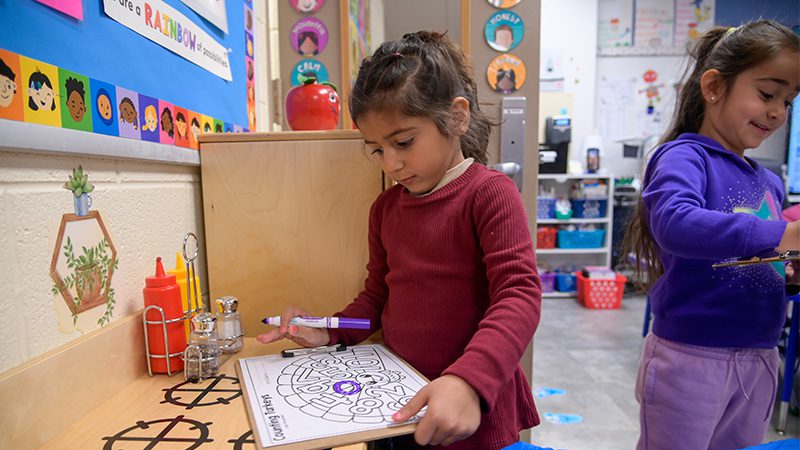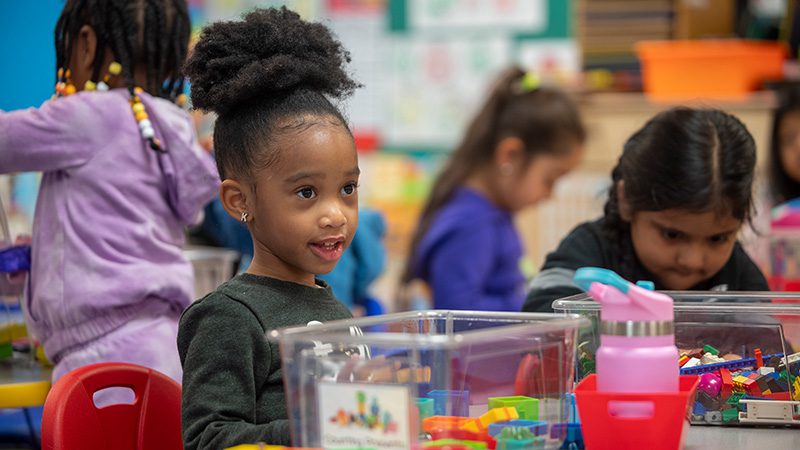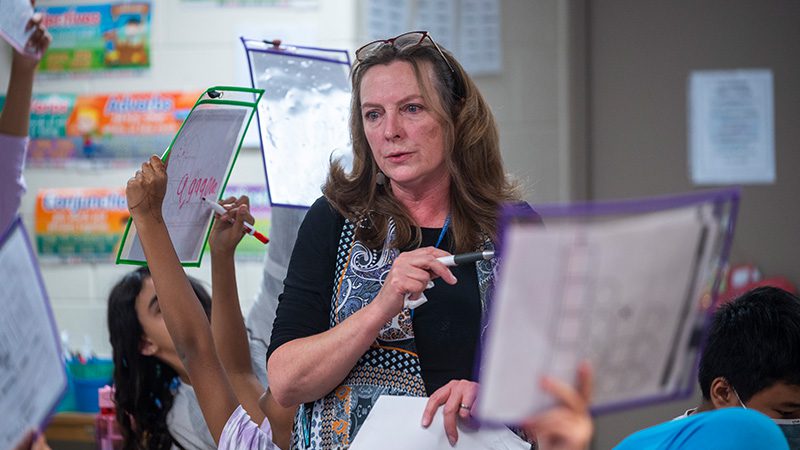Lean Elementary
Collaboration and Caring Add Up to Progress at Warren’s Lean Elementary
By Cassandra Spratling
Five first graders sit in a semi-circle around a table in the classroom of Souha Mansour as she guides them to answer questions, then speak in complete sentences.
“Everybody, what is this?” she says pointing to the object.
“A horse,” they respond in unison.
“Let’s say the whole thing,” she instructs.
“It is a horse,” the students say together.
“Is it a dog?” she asks.
“No,” the students answer back.
“What is this?” she asks again.
“It is a horse,” they respond.
“Is it a dog,” she asks.
“No,” they say.
“Say the whole thing,” she instructs.
“It is not a dog,” they reply.
The lesson continues as she points to different objects in the classroom and in the workbook on the table in front of each student. The floor. The bookcase. A box. A wagon.
When she notices a student not responding, she calls on that student to say the full sentence alone. The pattern of teacher questioning to identify an object in the classroom or in the workbook repeats over and over again. The teacher asks. The students respond. It goes on until the teacher is confident every student knows how to speak in complete sentences and is comprehending.
The 30-minute session is one of 10 sessions Mansour will do with small groups of students who are learning to improve their English while also learning other subjects at Lean Elementary School in Warren, a blue-collar community north of Detroit and Michigan’s third largest city.
English is not the first language spoken by parents in many of these students’ homes. Helping these students speak and understand English is a particular focus at Lean where 25 different languages are spoken among the nearly 600 students grades pre-K to 5. About 35 percent of the students are Bengali.
Mansour’s group of five first graders during a recent session represent that diversity. The five students come from families from four different countries. Two students come from homes where the families’ first language is Bengali; one, Arabic; another Vietnamese; and a fifth, Albanian.
Kids need to see themselves so that they can feel seen by others, feel connected to the community, and feel that they matter and are important … It helps them feel a part of the world in which they live. Seeing themselves in books gives them positive self-perceptions and increases their sense of self-esteem and self-worth. Furthermore, if kids see themselves in books, it will ultimately lead to increased reading skills since they will be able to make better connections, allowing for better comprehension.”
Media Specialist

Repetition is a key strategy for teaching English Learners at Lean, part of a curriculum called “Language for Learning” and “Language for Thinking” that is used in the Warren Consolidated Schools. It’s one of the strategies proving successful at Lean where English Learners consistently showed above average growth in Math and English Language Arts from 2017 to 2019, according to data reviewed by The Education Trust-Midwest. Black students and students from low-income households also showed above average growth in math and English Language Arts. For example, in 2019, 46.7 percent of Lean’s English Learners showed above average growth in math compared to 29.39 percent of students statewide. That same year, 53 percent of Lean’s students from low-income households showed above average growth.
Educators at Lean believe the Language for Learning/Language for Thinking curriculum, begun about 2017, is a big part of what’s leading to improvements.
Mansour admits she wasn’t a fan of the program when it was first instituted because it requires so much repetition. But she soon became a believer as she noticed non-native English-speaking students were soon speaking better, reading better and understanding what they were reading.
Students went from speaking in incomplete sentences and struggling with English to learning to speak using whole sentences, she said. “If they’re not saying it and hearing it, it’s harder to read it and to put it on paper,” Mansour says.
Strong educator team leads the way
Mansour is a part of a strong teaching and support team that contributes to Lean’s progress, says Principal Kerry Keener, who’s in his seventh year at Lean. The school’s 25-member teaching team is supplemented by two full time English Learner (EL) Teachers, one full-time EL aide, a full-time Title 1 teacher and two half-time Title 1 teachers. Title 1 teachers are paid with federal funds aimed at helping students from low-income households to succeed. There is other support staff as well, including a full-time speech therapist and full-time counselor.
“The main way we work with our English Learners is through pull-out programs,” Keener said. Students are placed in small groups based on their performance on various assessments, including an annual assessment of their fluency with the English language.
The small group instruction with Ms. Mansour’s class is an example. For 30 minutes, she worked with the students, helping them practice and learn speaking in whole sentences.
Additionally, the English Language and Title 1 classrooms are located right across the hall from each other, which facilitates communication and collaboration between the teachers. Some students receive small-group instruction from teachers in both classrooms. In addition, using data from state and national assessments, the school provides specialized small group instruction and support to students from low-income backgrounds who score below state proficiency standards.


-
Collaboration and data-driven. Four times a year, there’s a meeting of what’s called the multi-tiered support system team. The team consists of the principal, grade level teacher or teachers, and the support staff that includes the EL teachers, Title 1 teachers, counselor and special education staff. “It’s really a team effort,” Keener says.
Together, they review data on each student’s progress to determine what adjustments need to made to help students who are not progressing and what can be done to further push and promote those who are.
Keener said the multi-tiered meetings offer an effective way to review student progress, determine who’s making gains and who isn’t. From there, necessary adjustments can be made to help fill the gaps for those who need it and propel those who are already meeting standards.
A can-do-attitude. Keener said Lean’s motto -- “Every kid is a champion” -- builds on the educational philosophy of nationally-acclaimed education advocate Rita Pierson’s mantra.
“We've kind of fed off that Rita Pierson quote and turned it into our own little thing of every kid is a champion to…build the positivity and build the self-confidence and self-esteem in these kids who need it on a daily basis,” Keener says. The mantra reinforces the notion that every child can be successful, no matter their background.
The champion spirit is visible at Lean. A giant billboard on the front of the building states, “WELCOME: WE ARE THE CHAMPIONS!” Kids have t-shirts that say “I am a champion” and inspiring quotes are prominent throughout the halls. “I AM LIMITLESS!” “I AM CAPABLE!” “I STRIVE TO IMPROVE MYSELF!” are just a few of the motivational messages that students encounter daily.
Culturally-responsive resources and instruction. Those include library resources and classroom materials that celebrate diversity. The entryway to the spacious library displays an assortment of books with people of color. Media Specialist Marian Cardamone says it’s important that all students see students who look like them in books and other literature. She searches for books with characters from the specific countries or ethnic backgrounds of Lean’s student population: African-American, Africa, Bangladesh, Yemen, Pakistan, Iraq, Syria, Vietnam, Philippines, Korea, among them.
“Kids need to see themselves so that they can feel seen by others, feel connected to the community, and feel that they matter and are important,” Cardamone says. “It helps them feel a part of the world in which they live. Seeing themselves in books gives them positive self-perceptions and increases their sense of self-esteem and self-worth. Furthermore, if kids see themselves in books, it will ultimately lead to increased reading skills since they will be able to make better connections, allowing for better comprehension.”
Parent Shahnaz Haque, who has a 5th grader at Lean and two older daughters who graduated from there said the library resources is one of the many things she likes about Lean. She remembers her daughter excitedly telling her, “Look, Mommy! Here’s a book about people where you’re from,” said Haque, who is from Bangladesh. And the books aren’t just good for her children. “Other kids can get to know about other cultures too,” says Haque, who works as a lunchroom supervisor at Lean.
Cardamone agreed. “Kids who see someone in a book who may not look like them will gain important skills in empathy, it will give them a wider world view, and also show them that we are more alike than unalike,” she said.
A strong and caring staff. “I’m so proud of my teachers. They care for these kids. If kids see you really care for them, they’ll perform better for you,” Keener said. “It encourages kids to take chances and feel comfortable learning.”
“It's hard for me to talk about them without getting emotional, to be honest with you. What they have went through in the last two and a half years with a pandemic, and ‘Are we virtual? Are we hybrid? Are we in-person? ... With kids coming in with not a lot of schooling… So, the heavy load and lift that my teachers have had to take on along with dealing with their own lives and things like that, I'm so proud of them…just for them to keep the ship -- or keep the canoe or whatever -- rowing in the same direction, has been outstanding.’
Principal Keener never mentioned himself as a factor in the school’s success, but others did. And it’s evident in his actions. When the school was closed due to the pandemic he personally visited the homes of about 400 families, many multiple times, to deliver books and other learning material.
During a recent visit to the school, he was spotted sweeping the cafeteria floors between the school’s three lunch periods. And he regularly spends lunch hours in the cafeteria where he gets to know students and they get to know him. Asked why a principal would be sweeping the floor, he simply responded, “We don’t want kids slipping on grapes.”
That’s Lean: a school where every detail matters and everyone pitches in to ensure students’ success.